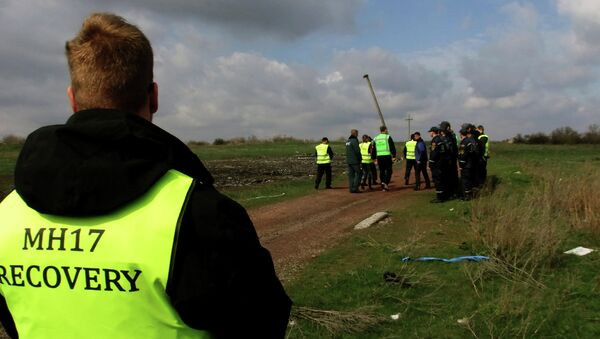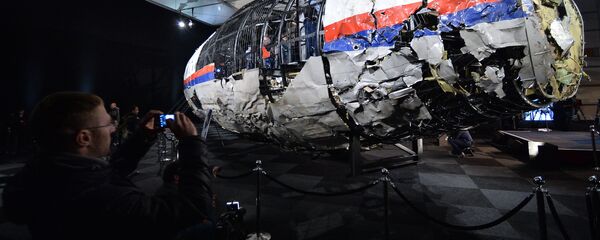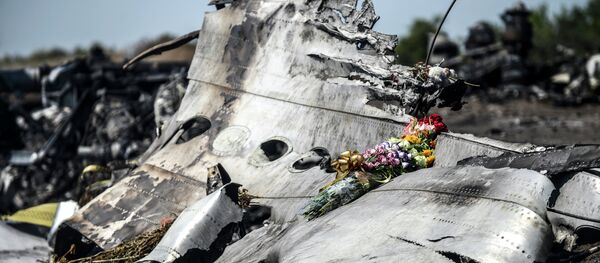The airliner’s fragments were subsequently located near the village of Hrabove, not far from the city of Torez in the Donetsk Region, on a territory controlled by militias from the self-proclaimed Donetsk People’s Republic.
In the evening of July 17, Ukrainian President Petro Poroshenko called the incident a “terrorist attack,” with Anton Gerashchenko, an adviser to the Ukrainian interior minister, noting that the plane had been downed by a Buk surface-to-air missile system (SAM). Authorities in the Donetsk People’s Republic said they had no weaponry capable of shooting down a plane at such an altitude. The United States, the United Kingdom and Australia supported Kiev’s allegations and claimed that the airliner had been downed by a surface-to-air missile from a territory controlled by militias. Subsequent statements noted that the European Union should revise its relations with Russia after pro-Russian separatists had downed the plane.
A Ukrainian Sukhoi Su-25 Frogfoot attack plane was also flying near the Malaysian airliner shortly before the crash. Russian military experts said Moscow had never transferred Buk SAMs or any other military equipment to militias in Ukraine. They noted that Ukrainian video footage of a missile launcher allegedly being redeployed to Russia posthaste was frame-up. Lt. Gen. Andrei Kartapolov, Chief of the Main Operations Directorate of the Russian Armed Forces’ General Staff, said a US satellite was flying over eastern Ukraine on July 17 and urged Washington to release satellite data. But the United States side did not comply.
On July 23, representatives of the US intelligence community openly noted that the Malaysian Boeing could have been downed by a poorly trained militias' crew by mistake. They said the US side had no evidence indicating that any Russians had been present at the launch site or that they had trained militias to operate the Buk missile system. Intelligence operatives admitted that they had obtained some information from social networks and video footage posted by Ukrainian authorities.
On July 21, the UN Security Council passed a resolution on the Malaysian Airlines Flight MH17 crash, calling for an unbiased international investigation and urging that the culprits be brought to account. Two days later, Dutch authorities officially assumed control over the investigation and said it would involve 24 experts from Russia, Ukraine, Malaysia, Australia, Germany, the United States and the United Kingdom. On September 9, 2014, the Netherlands published a preliminary report stating that the Malaysian airliner had disintegrated in midair due to structural damage caused by the external impact of numerous high-speed objects. However, the source of these objects was not identified. A spokesperson for the board of inquiry said the plane had, in all probability, been downed from the ground.
The concern’s experts believe that the Malaysian plane was downed by a missile that has not been manufactured in Russia for a long time but that is still operated by Ukraine. The missile was allegedly launched from near the Zaroshchenske village, which is controlled by Ukrainian military units. The Russian Defense Ministry mentioned this area a few days after the tragedy. In June 2015, while waiting for the final report on the causes of the crash, Dutch and Malaysian governments entered into talks on establishing an ad hoc international tribunal under the UN auspices that would assess the causes of the crash and punish the culprits.
On July 9, the Malaysian delegation at the United Nations circulated the relevant draft resolution, referring to the tragic crash as a threat to international peace and security.
On July 29, the UN Security Council’s members discussed an initiative by several countries to establish an international tribunal to investigate the air crash in Ukraine. The Russian delegation vetoed the draft resolution. Earlier, Russian Foreign Minister Sergei Lavrov called the air crash the result of a criminal offense, rather than a threat to international peace and security, as stipulated by the draft resolution. He said the UN Security Council had never established tribunals in connection with air crashes, and that the idea of establishing this tribunal aimed to convict those branded as guilty by Washington.
He added that the Russian side still had many questions regarding the continued investigation.
After the UN Security Council failed to pass the draft resolution on establishing the international tribunal, Malaysian Prime Minister Najib Razak said his country would continue to demand justice in connection with the Boeing 777 crash in eastern Ukraine using a variety of legal options. In mid-September 2015, the Prosecutor-General’s office of the Donetsk People’s Republic received 2,500 fragments of the Malaysian Boeing 777 that crashed in Donbas in July 2014, which were collected by local residents. The Republic’s Acting Prosecutor-General Andrei Spivak asked Dutch Chief Prosecutor Fred Westerbeke to take away the fragments found in Donbas.
On September 28, Dutch experts and members of the OSCE mission arrived at Hrabove in the Donetsk Region, where the Malaysian Boeing 777 had crashed in July 2014. They spoke with local authorities and also studied the territory.
After Russian experts studied the final Dutch report, Rosaviatsia Deputy Chief Oleg Storchevoi sent a letter to the Dutch Safety Board chairman in January 2016, noting that the studies and full-scale experiments conducted by Russian experts showed the Dutch side’s findings to be unreliable. In June 2016, a joint international group comprising investigators from 12 countries, including the Netherlands, Australia, Ukraine, Belgium, Malaysia, the United Kingdom, Germany, the Philippines, Canada, New Zealand, Indonesia and the United States, investigating the Malaysian airliner’s crash in Ukraine, published a report highlighting problems linked with the lack of experience in investigating such major disasters and the inadequate knowledge of specialized terminology.
According to the Office of the Dutch chief prosecutor, a report containing information about the weapons system used to down Flight MH17 in Donbas will be published in the autumn of 2016.







